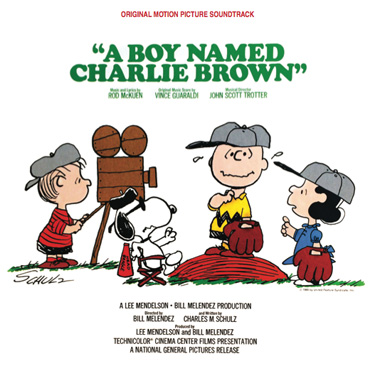
A track-by-track analysis of A Boy Named Charlie Brown

Vince Guaraldi’s fans have long hungered for a variety of things that are believed lost or buried in somebody’s attic: his February 1957 appearance on the TV show Stars of Jazz, as a member of Cal Tjader’s Quintet; the 5-minute solo piano “bumpers” made for National Educational Television stations in the mid-1960s, as a means of filling out one-hour time slots; and isolated music scores, akin to the Charlie Brown Christmas album, for all the other early Peanuts TV specials (and, most particularly, It’s the Great Pumpkin, Charlie Brown).
But perhaps the most tantalizing item — the Guaraldi Holy Grail — has been Vince’s score for the 1969 big-screen Peanuts movie, A Boy Named Charlie Brown.
The film did produce a soundtrack, which was issued by Columbia Records (OS 3500). The LP was not a score, though, but a “story of...” concept album that featured the film’s dialogue over every bit of music: some of it even recorded specifically for the album, as the film itself proceeds for long stretches without dialogue. This storybook concept had some value before home video, when there was no other way to “take home” a movie.
Fans therefore knew that Guaraldi’s score-only tapes must have existed somewhere ... and, indeed, they did. But the rights issues were a nightmare: Columbia Records had ceased to exist decades earlier, asset ownership passing along to a number of subsequently corporate entities. The music itself also posed challenges, as it involved not only Guaraldi’s representatives, but those associated with John Scott Trotter and Rod McKuen.
Frankly, it seemed hopeless.
Until now.
Thanks to soundtrack label Kritzerland, and the dedicated efforts of a few individuals, a project that literally has been years in the making (a phrase I’ve always wanted to use!) has come to fruition. Their new CD makes the complete Guaraldi/McKuen/Trotter film score a reality, and the album also features all sorts of previously unreleased tracks.
I’ve detailed the story of the film score’s creation in a lengthy essay for the CD liner notes; it also can be read at Kritzerland’s website. Additional information about “Dr. Funk” can be found at this site, which is a companion to my Guaraldi biography.
Derrick Bang
Author, Vince Guaraldi at the Piano
*********
What follows is a track-by-track discussion, for fans who like to know precisely where each score cue occurs within the film.
The movie itself remained inexplicably unavailable on DVD for a long time, before Paramount finally produced a digital version in March 2006. Worse yet, the original videotape releases—by Fox Home Video and Paramount Home Video—were edited, running only 79 minutes instead of the full 86 minutes. Fortunately, the Paramount DVD and Blu-ray releases both feature the full, unedited film.
(See the entry for Track 7 for additional details concerning differences between the original and truncated versions.)
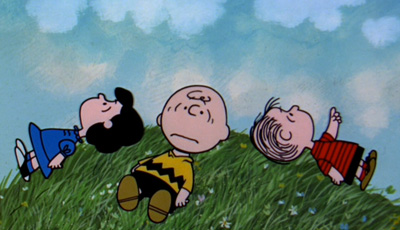
1. Champion Charlie Brown (Logo)/Cloud Dreams
The Cinema Center Films logo unspools to a brief, up-tempo instrumental quote from Rod McKuen’s “Champion Charlie Brown.” This segues neatly to John Scott Trotter’s “Cloud Dreams,” which delivers a thoughtfully cheery background as Charlie Brown, Lucy and Linus recline on their backs and picture images in the clouds passing overhead. After hearing Linus recite a litany of impressive sights, Charlie Brown reluctantly says — one of the poor blockhead’s many iconic statements — “I was going to say I saw a duckie and a horsie, but I changed my mind.”
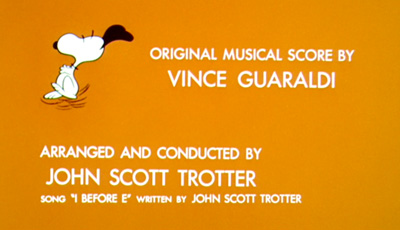
2. Champion Charlie Brown (Main Title)/A Boy Named Charlie Brown (Vocal: Rod McKuen)
A longer instrumental version of “Champion Charlie Brown” — the first of the film’s half a dozen or so instrumental variations on this theme, most of which run slightly more or less than a minute — plays as the title credits appear on the screen, identifying both the craftsmen (Charles M. Schulz, Lee Mendelson, Bill Melendez, Guaraldi, McKuen and so forth) and the animated stars: Charlie Brown, Linus, Lucy and the rest of the gang. More than any other version on the CD (except the vocal), this take on “Champion Charlie Brown” sounds very much like an anthem for Charlie Brown’s upcoming adventures, and reflects the song’s triumphant nature (even though we haven’t yet heard the lyrics). The credits conclude as Snoopy “plays vulture” on a sagging branch; the branch gives way and spills the world-famous beagle into Lee Mendelson’s directing credit, scattering the letters all over the screen.
As the final credit fades, McKuen’s vocal version of the title song, “A Boy Named Charlie Brown,” is heard as Charlie Brown makes and then tries to fly a kite ... twice. The action is completely silent, aside from McKuen’s song and a few sound effects, and yet the scene speaks volumes about poor Charlie Brown’s lot in life.
“I wanted the music to be somewhat melancholy,” McKuen noted. “I wrote this song as a blues number — Sparky and Vince absolutely loved it, but at first they were the only ones — because I wanted to go to the inner Charlie Brown. And I was able to have ‘Champion Charlie Brown’ to balance it, so I wasn’t worried.”
As compared to McKuen’s second vocal take on this song, at the end of the film [Track 22], this first reading emphasizes the song’s wistful and melancholy nature.
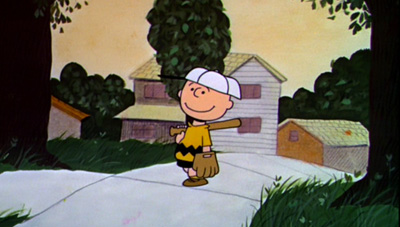
3. Kite Music (Lucifer’s Lady)/Charlie Brown and His All-Stars
As McKuen’s song fades, Guaraldi debuts one of his own compositions, to accompany Charlie Brown’s further efforts to fly his kite. Poor Chuck still gets nowhere, gives up in frustration and tosses the kite to Lucy, who in turn gives it to Snoopy ... who immediately gets in into the air, where it soars alongside numerous kites being flown by the other kids.
“Lucifer’s Lady” actually is this film’s only Guaraldi cue that does not originate with one of Dr. Funk’s earlier Peanuts albums. Although the title seems to reference Lucy, Guaraldi chose to release a much longer, more acid-hued version of this track on his RCA album, The Eclectic Vince Guaraldi, where it’s not generally regarded as one of the composer’s many Peanuts themes.
As the kite scene fades with this track, the music shifts to a lengthy version of Guaraldi’s sprightly baseball anthem, “Charlie Brown and His All-Stars,” as Chuck happily heads down the sidewalk. This cue, perhaps even more than “Linus and Lucy,” beautifully showcases the lively and yet simple keyboard work that Guaraldi made such a signature in his Peanuts scores; it’s impossible to hear “Charlie Brown and His All-Stars” without breaking into a smile. With some subtle shading from the violins, this cue is all about optimism and that sense of wonder with which children greet every new day, knowing that something magical might happen.
(This cue appears only one more time during the film [Track 21], at which point the mood will be completely different.)
“My heart is full on the day I first go out to the ol’ ball field,” Charlie Brown happily thinks, but this good cheer is derailed when he finds his pitcher’s mound covered with dandelions ... which the other kids refuse to let him remove. “Charlie Brown and His All-Stars” continues to play in the background as Snoopy hustles a phonograph and speakers from his doghouse; once everything is plugged in, the gang stands at attention as Trotter’s arrangement of “The Star Spangled Banner” [Track 24] plays against an op-art collection of flag-like stars, stripes and patriotic images. (Yellow Submarine, which had been released not long before this film, seems to have influenced this sequence, along with a few others further along in the film.)
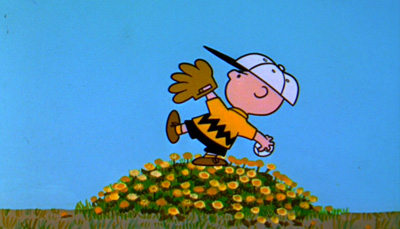
4. Percussion Swinger/Baseball Theme
As “The Star Spangled Banner” fades, a bongo arrangement of Guaraldi’s other baseball tune rises, as Snoopy hastily removes his audio equipment and then takes the field with the rest of the gang. It’s time for some serious baseball action as everybody warms up, and Guaraldi’s piano yields the melody line to a muted trumpet as the track becomes even sassier. The music fades and finally pauses for a few minutes, as, with the players assembled on the field and ready to start the game, Schroeder walks to the mound to discuss his signals with Charlie Brown.
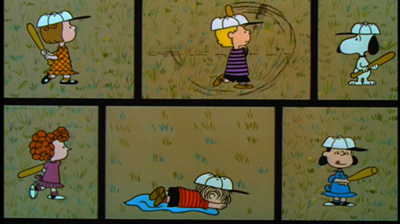
5. Baseball Theme (Charlie Brown Pitches)
This wonderfully jazzy and much longer rendition of the same cue picks up as the baseball game progresses, Charlie Brown getting knocked out of his clothes and having to re-dress — twice — thanks to particularly vicious line drives. Guaraldi improvises with some serious keyboard riffs as Lucy approaches the mound and suggests that Chuck throw a bean-ball; when he indignantly refuses, the argument erupts into a massive debate on the pitcher’s mound, involving all the players. This naturally prompts another of Charlie Brown’s signature lines: “We never win any ball games, but we sure have some interesting discussions!”
The piano shifts to counterpoint as first a sax and then an electric guitar take over the energetic melody line; the tempo and volume build as Charlie Brown finally gets his team back in their assigned places, pitches the next ball ... and gets clobbered.
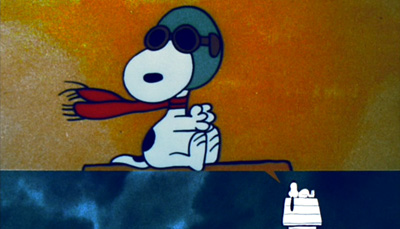
6. Baseball Theme (Three Strikes and You’re Out)/A Boy Named Charlie Brown (We Lost Again)/Air Music (Snoopy Theme)/The Red Baron Strikes Again
Charlie Brown regains his senses and continues the game as Guaraldi’s “Baseball Theme” is heard for the third and final time, now with a full orchestra, as Mendelson makes inventive use of a split screen to show the team going down in flames. Listen for Guaraldi’s spirited piano counterpoint about 1 minute into the cue, as he really goes to town. The music builds to what we expect will be a fanfare, but then ratchets back as the game finally concludes with a wail of anguish from the gang, at which point...
...the music shifts to an instrumental reading of “A Boy Named Charlie Brown,” as poor Chuck trudges home alone and takes a bath (where his boat sinks, of course). Strings are highlighted every time this theme is used, even as an instrumental, suggesting the song’s heavy-hearted lyrics even when we don’t hear them. McKuen’s song continues in the background as Charlie Brown sits on his porch step with Linus, who wisely insists that his friend will win at something one of these days (while beating him at tic-tac-toe).
As Linus leaves, a hungry Snoopy appears and the music shifts to Guaraldi’s vibrant “Air Music,” as Charlie Brown hastily dumps some food in Snoopy’s supper dish. The horn section takes the lead, with Guaraldi’s piano providing counterpoint, and longtime fans will notice that this familiar cue is played at a somewhat slower tempo than usual. The beagle devours his meal, falls asleep and then, thanks to a grumbling stomach-ache, dreams himself into an adventure as the WWI Flying Ace.
The moment the Flying Ace takes to the skies in his Sopwith Camel (his doghouse), the music shifts again to an original Trotter composition called “The Red Baron Strikes Again.” The WWI Flying Ace roars through the skies, the Red Baron in hot pursuit, and when things turn grim, Snoopy finally awakens, charges to the house and kicks Charlie Brown’s back door. (This takes place, it should be noted, in the middle of the night.) When Charlie Brown answers, Snoopy scurries past him and snuggles into his master’s bed, as Trotter’s jittery theme yields smoothly to a final few bars of Guaraldi’s “Air Music” ... leaving Charlie Brown to wonder aloud, “Why can’t I have an ordinary dog like everybody else?”
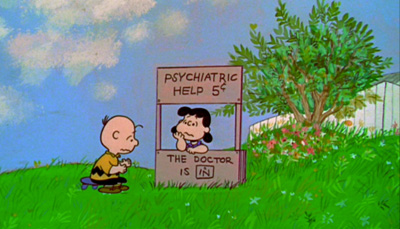
7. Blue Charlie Brown
Still despondent over his team’s most recent loss, Charlie Brown twists his own knife with a visit to Lucy at her psychiatric booth. She begins by adopting one of her newest treatments: torturing poor Chuck with a slide show of his faults projected onto a screen. Although the first few are shown — such as his tendency toward “fatness” — we subsequently get only a reaction shot as Charlie Brown endures the images of “his most damaging faults.”
This entire sequence unfolds against a swinging rendition of Guaraldi’s “Blue Charlie Brown,” a bluesy, finger-snapping track that some observant listeners will realize runs far longer than this action in the film. (Six whole minutes ... WOW!) The reason? This scene suffered a heavy edit after the film’s initial release. In the full-length print, after the horrific slide show, Lucy takes Charlie Brown outside for some “football therapy,” but (naturally) pulls the ball away before he can kick it; she then employs an instant-replay camera to show Chuck missing the football, thereby demonstrating his “failure face.”
When Charlie Brown stumbles into his house and mutters, “I’ve never gone through anything like that in my life,” it seems — in the film’s edited version — that he’s referring to the slide show ... but, in fact, he’s commenting on the embarrassment of watching that slo-mo football failure.
The full-length film, at 86 minutes, was released in 1969, but after its initial theatrical run, every subsequent TV airing — whether on network television, cable’s HBO or the Disney Channel — was of the edited 79-minute version. The same was true of all early VHS releases of the film; you couldn’t watch or purchase the original full-length version for love or money for nearly four decades! Small wonder, then, that most people — even avid fans — will find this arrangement of “Blue Charlie Brown” so unusually long; they’ve never heard this music accompany anything but a heavily edited version of this portion of the movie.
Fortunately, Paramount finally released the original 86-minute version on DVD in March 2006. Newer viewers, only catching up with the film as of this DVD release, therefore will find a better music-to-action match between the movie and this recording of “Blue Charlie Brown.”
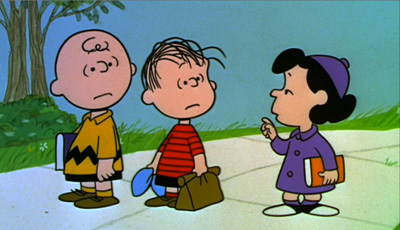
8. Linus and Lucy (Time to Go to School)/Champion Charlie Brown (I Only Dread One Day at a Time)
Having only barely survived his ordeal with Lucy, Charlie Brown stumbles home and into his bedroom, as a short, dirge-like reading of “Champion Charlie Brown” plays primarily on guitar and flute. It’s the perfect counterpoint to ol’ Chuck’s lament that “These psychiatric treatments are going to bankrupt me!”
The next day, it’s time for school, as bossy big sister Lucy hustles Linus out of bed. (“Again?” he wails. “I went yesterday!”) This scene marks the film’s debut of Guaraldi’s signature Peanuts theme, “Linus and Lucy,” although this leisurely, fairly short version — with its chirping flute — seems a slight echo of its usually happier self.
The track segues smoothly into another instrumental reading of “Champion Charlie Brown,” as Linus catches up with Charlie Brown, and the two walk toward school together. This cue is somewhat downcast, as a guitar and flute take the melody line, reflecting Charlie Brown’s wish for some sort of victorious achievement. The track builds to a melancholy crescendo as Linus encourages Charlie Brown to “try to win at something,” which prompts the nearby gaggle of girls to guffaw and insultingly suggest that Chuck enter their classroom spelling bee. When Charlie Brown does show interest, the instrumental track abruptly cuts to...
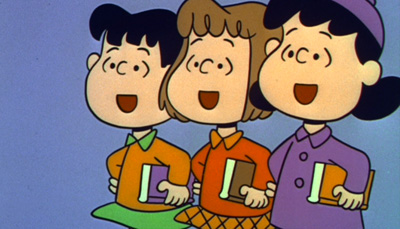
9. Failure Face (Lucy, Violet, Patty)/Catatonic Blues
...the girls taunting Charlie Brown while dancing in a circle around him and singing McKuen’s “Failure Face,” as wincingly cruel a song as one could imagine. (“And in the race to be stupid ... you set a brand new kind of pace!”)
McKuen stood by these lyrics. “Kids are mean!” he said. “That’s exactly the way kids treat other kids. The scene needs it!”
As the song’s lyrics finally fade, leaving viewers to wonder if any child ever could survive such a verbal pasting, the scene shifts to Charlie Brown seated at his classroom desk. An original Trotter instrumental titled “Catatonic Blues” plays somberly in the background, as Charlie Brown argues with himself over whether to enter the spelling bee (“My hand won’t go up! My hand is smarter than I am!”), but he finally finds the courage and takes a place alongside the entrants.
And, for the first time, the film eschews its musical accompaniment for several minutes, as Charlie Brown participates in — and wins! — his classroom spelling bee.
Oddly, this triumphant moment takes place amid absolute silence from the score, which leaves the scene feeling rather anti-climactic. The original soundtrack LP inserted an instrumental reprise of “Champion Charlie Brown” behind this scene, which is much more fitting.

10. “I” Before “E” (Charlie Brown, Linus)
But the ordeal ain’t over. Following this victory, Charlie Brown discovers that he’s now automatically entered in the All-School Spelling Bee. This means more studying, so Linus helps his friend navigate the arcane mysteries of English spelling by turning the experience into the extremely clever patter song, “I Before E.” Snoopy joins the musical action by dancing and playing his twanging mouth harp, and the scene eventually blossoms into a Warhol-esque sequence of gigantic words and op-art swatches of color.
Trophy Music Co. released one of this film’s few promotional tie-ins: the “Snoopy’s Harp,” which came packaged in a small white box that promised purchasers they could “Make new sounds on one of [the] (sic) world’s oldest instruments ... it’s fun ... it’s easy.” The box included “complete instructions” on a tiny, single-fold piece of paper that was conspicuous for its lack of Peanuts artwork. (Let it be noted, as well, that playing the darn thing isn’t nearly as easy as Snoopy makes it seem!)
By the time this song concludes, everybody knows it’s “I before E ... except after C!”
Melendez, whose professional career began when he became part of the animation team working on Disney films such as Pinocchio, Fantasia, Bambi and Dumbo, soon became much better known as the animator behind Charlie Brown’s leap from the newspaper comic pages to television and, later, the big screen. In the early ’60s, Melendez and Schulz had collaborated on a series of black-and-white animated spots for Ford’s new Falcon automobile: truly adorable TV commercials that marked the small-screen debut of Charlie Brown, Snoopy and the rest. These, in turn, led to a season’s worth of “steady employment” on television’s Tennessee Ernie Ford Show, where the Peanuts gang introduced their star each week. Melendez also performed the voice of Snoopy (and later Woodstock) for the Peanuts specials.
Al Shean was one of the graphics designers on Melendez’s team. It’s a shame the two never collaborated on any other songs, because they certainly had Tom Lehrer’s gift for clever and complicated rhymes.
The film’s music track then recedes again, as Charlie Brown enters and survives several rounds of the All-School Spelling Bee...
...but then gets stuck on a word! Snoopy, overhearing the action while listening outside a window, whips out his mouth harp and, by setting a beat that Charlie Brown overhears, reminds him of a relevant portion of the “I Before E” song. This brief mouth harp sequence is augmented by a glockenspiel, and, wouldn’t you know it...
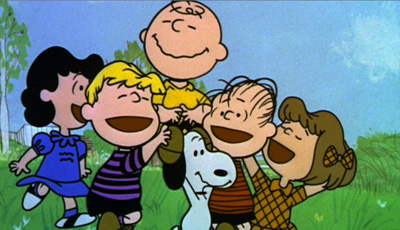
11. Champion Charlie Brown (The Gang)
…Charlie Brown wins again! This victory is too much for his friends, even naysayers Lucy, Patty and Violet: They all hoist Chuck onto their shoulders while singing McKuen’s “Champion Charlie Brown,” as triumphant a song as “Failure Face” was vicious. (McKuen deliberately intended this massive emotional swing.) No hometown hero ever was feted better, and the scene — and song — conclude as Linus fans Charlie Brown with his blanket.
McKuen confessed that this song had earlier roots; it originally was written for Goodbye, Mr. Chips, and it was called “Mr. and Mrs. Chips”:
Mr. and Mrs. Chips,
That has a lovely sound
Spoken by porters, when they go travelin’
Often to London town.
Arthur P. Jacobs, the producer of the 1969 musical version of Goodbye, Mr. Chips (in which Peter O’Toole starred), hired all sorts of folks to write songs; McKuen was one of many. Since McKuen’s work wasn’t used, he retrieved the rights; somebody involved with A Boy Named Charlie Brown heard “Mr. and Mrs. Chips,” and thought it was a great melody.
“Actually,” McKuen laughed, “it was a better song for Charlie Brown.”
And, once again, the film continues through the next several scenes without any music, as Charlie Brown discovers — to his horror — that now he’ll have to study and sweat out a competitive heat a third time, as a participant in the second grade round of the National Eliminations Spelling Bee.
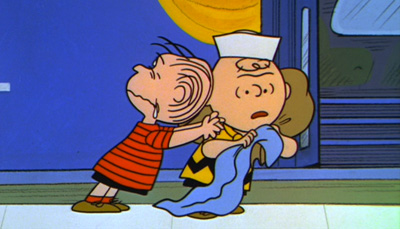
12. Oh, Good Grief/Champion Charlie Brown (Bus Station)/A Boy Named Charlie Brown
So, it’s back to the books. Charlie Brown studies hard, but can’t help noticing when younger sister Sally enters the room and flirts with Linus, as Guaraldi’s bouncy ode to unrequited love — “Oh, Good Grief!” — accompanies her actions. This brief musical cue segues smoothly to another instrumental reading of “Champion Charlie Brown,” this one using strings to give an air of what Jackie Gleason used to dub “traveling music,” as the kids give Chuck a great send-off the next day, when he boards a bus and heads for the big city. Linus, overcome with emotion, even gives his blanket to Chuck as a good-luck token.
“Champion Charlie Brown” repeats as the bus takes off, and this segues smoothly to an almost cheerful instrumental take on “A Boy Named Charlie Brown,” as Chuck takes a taxi to his hotel and checks into his room.
(At this point, the story detours into an extended sequence involving Lucy and Schroeder, which takes place as he plays the third movement of Beethoven’s Pathétique Sonata in C minor, Op. 13, on his toy piano [track 26, among this CD’s bonus tracks, with Ingolf Dahl handling the complex keyboard work]. Finally able to rid himself of this unwanted female admirer, Schroeder launches into the second movement, which unfolds against a visual Beethoven fantasy of images that wouldn’t have been out of place in Disney’s Fantasia.)
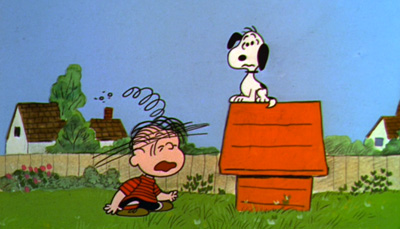
13. Linus and Lucy (I’ve Got to Get My Blanket Back)
Meanwhile...
Linus, suffering without his blanket, clearly in terrible shape, stumbles about to a slow reading of “Linus and Lucy,” this one in a minor key and with a positively mournful horn and flute counterpoint. Lucy is completely unsympathetic, so Linus persuades Snoopy to help him find Charlie Brown and get his blanket back.
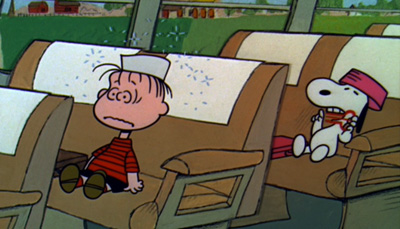
14. Bus Wheel Blues
Still dazed and wall-eyed, Linus boards a bus with Snoopy in tow, and the two settle back into their seats as a new Trotter instrumental, “Bus Wheel Blues,” speeds them on their way. Midway through this song, Snoopy becomes part of the musical action by once again pulling out his mouth harp. He’s one rhythmic beagle!
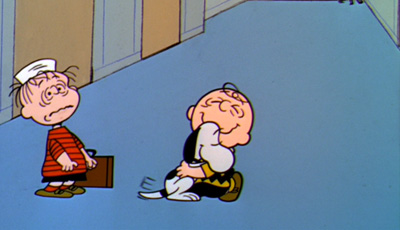
15. A Boy Named Charlie Brown (“I” Before Milk)/Champion Charlie Brown
Cut to Charlie Brown, holed up in his hotel room and studying as hard as he can, as the soundtrack serves up another melancholy strings reading of the film’s title theme. Poor Chuck is starting to spell the words in his thoughts, but when he flirts with the notion of turning around from his books, his dedication is re-fueled by a mental image of bossy ol’ Lucy, and her expectation that he’ll continue to do well.
Suddenly, there’s a knock on the door, and…
…cue the happy reunion, as Linus and Snoopy meet up with Charlie Brown. The three dance joyously to an abbreviated, march-style fanfare from “Champion Charlie Brown.”
But then the mood turns serious, as Linus discovers — to his horror — that Charlie Brown has no idea where his friend’s blanket might be. He eventually suggests that Linus and Snoopy check the hotel lobby and then the nearby city library, since those are the only two places Chuck has been, aside from his room. This entire lengthy scene unfolds with no musical accompaniment, which frankly seems a dramatic miscalculation; the action and dialogue seem a bit flat without some thematic counterpoint. (The original soundtrack LP doesn’t make this mistake, and scores part of this scene with a reprise of Track 8’s version of “Linus and Lucy.”)
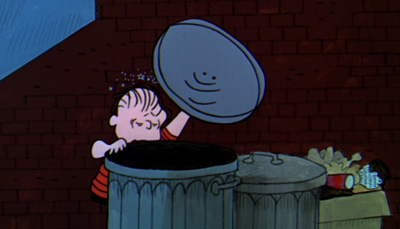
16. Linus and Lucy (Big City)
The score once more turns melancholy, with an even slower reading of “Linus and Lucy,” again in a minor key, as Linus searches trash cans and everything else along the way, while trudging toward the library on the darkened city streets. Suddenly, Snoopy spots the outdoor Rockefeller Center ice-skating rink, and...
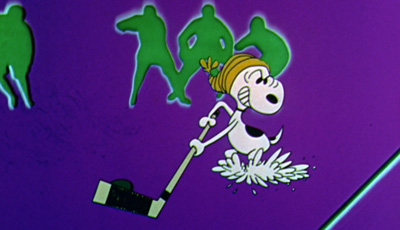
17. Skating/Blue Puck/Skating (Snoopy on Ice)
…the world-famous Olympic skater takes to the ice against a truly gorgeous, full orchestral reading of Guaraldi’s “Skating,” timed to Snoopy’s many jumps and twirls. After a little more than a minute of this, the music abruptly cuts to a Trotter original titled “Blue Puck,” a fast-paced jazzy number that serves as a counterpoint to Snoopy’s shift to the World-Famous Hockey Player, who loses quite a few teeth during the course of some furious play. This section runs about two-and-a-half minutes, and then the music shifts abruptly back to “Skating,” as the action settles down again, and it’s just Snoopy doing his figure-skating tricks. The scene concludes with a final orchestral “pop” that occurs about two seconds after “Skating” fades away at the end, punctuating Snoopy’s face-first fall onto the ice.
A note about this track: Guaraldi and the orchestra provided a longer version, running 6:22, which wound up unused as the animated action was edited and tightened; the extended track has been included as a bonus on this CD [track 29]. This alternate version fades out instead of including the final orchestral pop.

18. Linus and Lucy (Found Blanket)/Champion Charlie Brown (Spelling Bee)
Snoopy’s sports digression safely out of his system, the world-famous beagle resumes helping Linus search for his blanket, as the slow, minor-key rendition of “Linus and Lucy” reprises. The hunt is fruitless, and Linus and Snoopy return to Charlie Brown’s hotel room, with Linus trash-talking his absent-minded friend the entire way. Then, suddenly ... success! Charlie Brown has been using the blanket to polish his shoes! Linus grabs his beloved flannel friend, and the two perform a lively dance to (finally!) the classic, more traditionally upbeat version of “Linus and Lucy.” It’s the last time this song is heard in the film, and a sparkling final appearance.
And if that more jovial reading of “Linus and Lucy” sounds familiar, there’s a good reason. As my good friend and fellow Guaraldi fan Doug pointed out, it’s a one-minute excerpt from Vince's original score to the TV special It’s the Great Pumpkin, Charlie Brown, from three years earlier, in 1966. A close listen will reveal that — unlike the rest of this new soundtrack album — that brief stretch is in mono, with a bit more tape hiss. Have a listen, and then go look at the beginning of the TV special. It’s the very same performance, recycled for use in the 1969 full-length feature!
(The original soundtrack LP employed a shorter “Linus and Lucy” cue here, which is included as one of this CD’s bonus tracks, No. 30.)
This scene fades and shifts to Charlie Brown, Linus and Snoopy leaving the hotel and heading toward the auditorium where the spelling bee will take place; the music switches as well, to a lively, full orchestral version of “Champion Charlie Brown.” The mood is upbeat, as the cut concludes with a few bars of Woody Herman-style, big band swing while Charlie Brown stalks confidently into the auditorium as Linus and Snoopy take seats toward the front, thrilled to bits to be present for this great occasion.
(This trace of post-WWII-style swing probably isn’t accidental, since Guaraldi toured with Herman’s third Thundering Herd in the spring of 1956, replacing Nat Pierce on piano.)
At this point, the film includes a brief reprise of “Blue Charlie Brown,” as Charlie Brown climbs onto the stage while his friends, back at home, watch the action on television. As the music used is a brief quote from Track 7, it has not been repeated here.
The film then proceeds through its longest stretch without music, as Charlie Brown and eight other children wince, grimace, stutter and sweat their way through several rounds of the National Eliminations Spelling Bee.
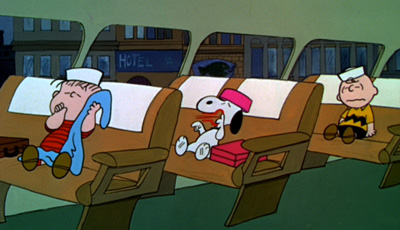
19. A Boy Named Charlie Brown/Bus Wheel Blues
Having blown his chance at victory, a desolate Charlie Brown is followed by Linus and Snoopy, as all three return to the hotel and pack, to the slowest and saddest-yet instrumental version — entirely strings and flutes — of “A Boy Named Charlie Brown.” (Honestly, you could just cry!) Nobody pays them any attention as they board the bus for the trip home; the music shifts to a reprise of Trotter’s “Bus Wheel Blues,” with Snoopy once again lending support on his mouth harp ... while poor Charlie Brown sinks lower and lower and lower into his seat.
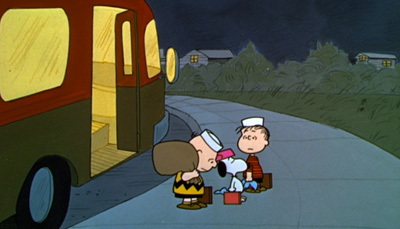
20. A Boy Named Charlie Brown (I’m Never Going to School Again)
Another dirge-like instrumental version of “A Boy Named Charlie Brown” picks up as Chuck and his friends arrive at their hometown bus stop in the middle of the night ... and, of course, nobody has stayed up to greet them. The three walk home along the silent, darkened streets; Linus bids good-night and enters his home first, and then Snoopy crawls on top of his doghouse. Charlie Brown is left to enter his house all alone; he unpacks, undresses, gets into bed and stares miserably into the camera, as the song slowly fades.
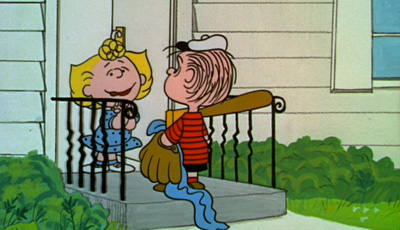
21. Charlie Brown and His All-Stars
The next day, a subdued reprise of “Charlie Brown and His All-Stars” — not as upbeat as the version in Track 3, and this time with an electric guitar, vibes, strings and sax carrying the melody line, rather than a piano — accompanies Linus as he knocks on Charlie Brown’s door and is greeted by Sally. This baseball anthem continues as Linus, carrying a bat and mitt, enters Charlie Brown’s darkened room, where his friend has hidden all day ... skipping school and refusing to leave his bed. Linus, although clearly sympathetic, listens to his friend’s lament, but then speaks the film’s wisest words: “But did you notice something, Charlie Brown? The world didn’t come to an end” [excerpted in Track 32].
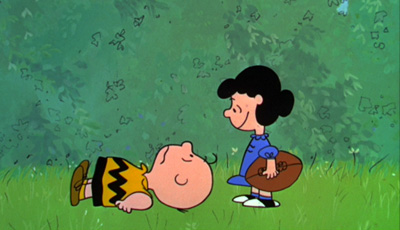
22. A Boy Named Charlie Brown (Vocal: Rod McKuen)
And, indeed, it didn’t. As a happier instrumental cover of “A Boy Named Charlie Brown” propels him, Charlie Brown gets up, gets dressed, and heads outside. His friends are occupied with their usual after-school fun and games, and everything seems right with the world; nothing has changed. Despite his recent disappointment, Charlie Brown cannot help smiling. And then ...
... he spots Lucy, playing with the football, as the music shifts to McKuen’s vocal reprise of his title song. As compared to McKuen’s first vocal take on this song, at the beginning of the film [Track 2], this reading sounds unexpectedly joyous, and one can imagine McKuen smiling as he croons the words. Charlie Brown sneaks up, naively believing that Lucy is unaware of his presence, and then charges for the football.
And misses when she yanks it away.
“Welcome home, Charlie Brown,” she says, with mock sweetness, and Charlie Brown knows it’s true: Nothing has changed!
McKuen’s vocal hits a crescendo, and the film cuts to its closing credits. The song concludes neatly as the final credits and the Cinema Center Films logo fade to black.
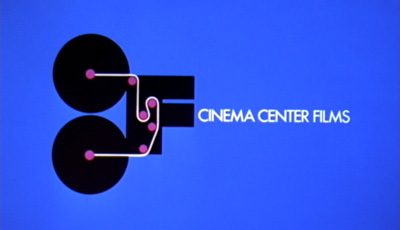
23. Champion Charlie Brown (Logo) (alternate)
This slightly longer and instrumentally different version of the cue heard in Track 1, this one in marching-band style, could be a remnant of an earlier edit, with a longer pause on the Cinema Center Films logo at the top of the film. This version of “Champion Charlie Brown” also concludes with the same two-chord question mark that then would segue to “Cloud Dreams.”
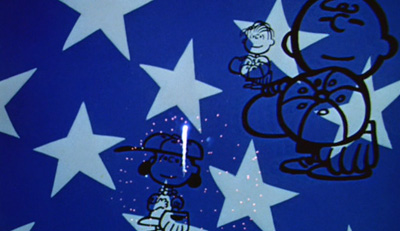
24. The Star-Spangled Banner (arr. Trotter)
This particularly stirring source music comes courtesy of Snoopy, who hauls out a massive stereo system — and turntable — and plays this anthem before Charlie Brown and the gang begin the baseball game toward the beginning of the film. For those wanting to sequence this cue properly, it comes immediately after Track 3 and just before Track 4.
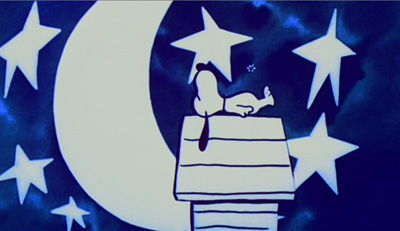
25. Air Music (Snoopy Theme)/The Red Baron Strikes Again (alternate)
This alternate cue begins with a version of “Air Music” that is much the same as heard in the film [Track 6], but it then segues abruptly to a shorter and distinctly different approach to “The Red Baron Strikes Again.” The piano-and-bongo attack is much more furious, and the mood and building tension are much more ominous. Apparently, this arrangement went with a shorter dogfight (in every sense of the term), because Snoopy wakens sooner from his nightmare — after only a minute, rather than 90 seconds — and “The Red Baron Strikes Again” segues again into the fading echo of “Air Music,” also as heard in the film.
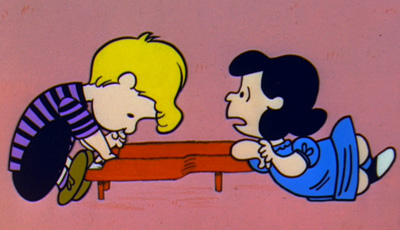
26. Sonata in C Minor, Op. 13 (3rd movement) (Ludwig van Beethoven)
Having bid farewell to Charlie Brown, with financial stars dancing in her eyes as the agent of a budding spelling champ, Lucy turns her attention back to boy-toy Schroeder, who of course has no time for her; he’s too busy playing some of his beloved Beethoven (the keyboard duties actually handled by Ingolf Dahl). Lucy’s flirtatious love banter finally annoys the toy piano keyboardist, at which point the music cuts abruptly ... as does this cue. (The scene actually continues for quite some time, and into the second movement of this Beethoven work, but that portion of the sonata is not included here.) For those wanting to sequence this cue properly, it comes between Tracks 13 and 14.
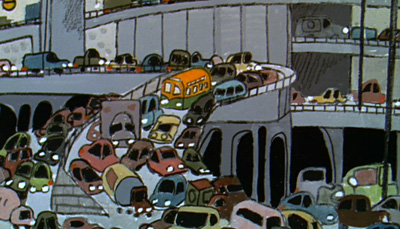
27. Bus Wheel Blues (alternate)
This much longer version of John Scott Trotter’s “traveling music” can be regarded as a “pure” orchestral arrangement of the song, notable both for its ominous horn undertone and the absence of Snoopy’s mouth-harp accompaniment. The horns — which turn positively scary as they crescendo during the worst moments of Linus’ mournful haze, as he suffers blanket withdrawal — give a strong suggestion that this isn’t a bus trip anybody would rush to take. That may explain why both film versions of this song sound much more carefree. After all, the wise and sweet Linus is the last Peanuts character we want to see dumped into what looks, for all the world, like an LSD trip gone bad.
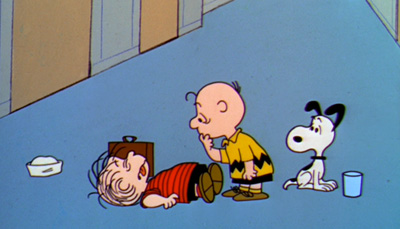
28. Champion Charlie Brown (Transition)
Nothing remotely like this track appears in the film, although its lively, Neal Hefti-esque approach to “Champion Charlie Brown” might have been used to put a happier spin on the scene where Linus and Snoopy are reunited with Charlie Brown in the big city.
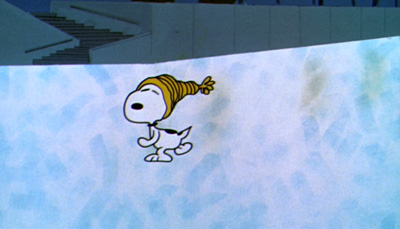
29. Skating/Blue Puck/Skating (Snoopy on Ice) (alternate)
These three blended tracks, more than a minute longer than the versions heard in the film [Track 17], can be considered the highlight of an album already filled with priceless goodies for Guaraldi fans. The primary difference is the opening arrangement of “Skating,” which runs a minute and a half longer here; Guaraldi takes his time with the melodic bridge and delivers a fully orchestrated masterpiece that can be considered the definitive version of this winter-themed melody. “Blue Puck” is pretty much as heard in the film, and then the reprise of “Skating” differs slightly from its film reprise, as this alternate take fades out sooner instead of concluding with the orchestral pop.
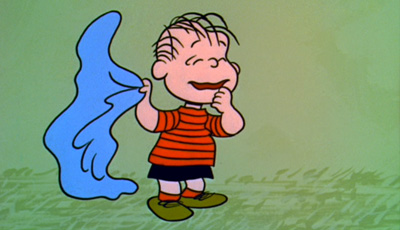
30. Linus and Lucy (Found Blanket) (alternate)
This much shorter version of the triumphant reading of Guaraldi’s signature hit apparently was recorded specifically for the soundtrack LP, which presents a quicker edit of the moment when Linus is reunited with his blanket [track 19, as heard in the film]. This arrangement would fit the scene if the music cut out just as Linus begins to dance with his blanket … but of course the rest of the scene screams for the song to continue.
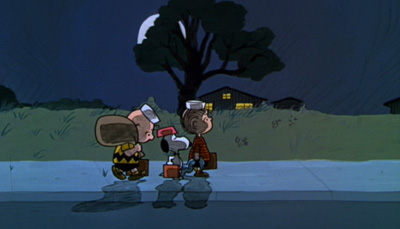
31. Champion Charlie Brown (unused jazz combo)
An entirely different version of this song, eschewing the film’s many orchestral arrangements and concentrating on a combo approach: primarily Guaraldi’s keyboards, with bass, drums, guitar and muted trumpet accompaniment. The result is a jazzy, mid-tempo swinger; one can imagine this being the version Guaraldi might have preferred, had he and his band released an album of instrumental covers of the film’s various themes. In point of fact, this version was recorded for the original soundtrack LP, where it’s used as underscore when Charlie Brown, Linus and Snoopy return home after poor Chuck’s dismal failure on national TV.
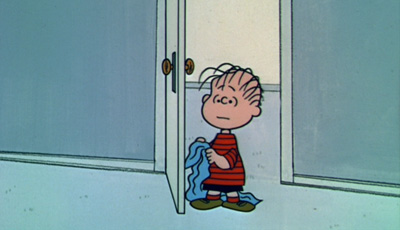
32. Words to live by - Dialogue (Linus, Charlie Brown)
A parting few words from Linus, Charles M. Schulz’s resident sage, who reminds us that tomorrow always is another day.